WALTHAMSTOW EAST
| This area of Walthamstow has within it Walthamstow Village and has some of the oldest buildings. For the origin of the name of Walthamstow see in Walthamstow West. |
CONTENTSSee Also pages for WALTHAMSTOW WEST WALTHAMSTOW VILLAGE 2. Antique Head 3. Beacon 4. Chapel End Murals 5. Church Hill Nursery Door 6. "Fellowship" 7. Lamb's Caf� 8. Henry Maynard Jun. Sch. Mosaic 9. Meridian Markers 10. Sir George Monoux College 11. Pig & Whistle 12. Plough 13. Lord Raglan 14. St Mary's C of E School Art 15. The Old Shop 16. South Sea Bubble 17. "Tragedy" 18. Waltham Forest College 19. Walthamstow War Memorial 20. Sir Robert Wigram |
PUT MOUSE OVER  TO READ NAME ~ CLICK FOR PHOTO & EXPLANATION.
TO READ NAME ~ CLICK FOR PHOTO & EXPLANATION.
 |
Tarnished Angel. |
|
Vallentin Road. This large figure of a winged angel with a neon halo stands on the roof of a maker of electric signs. Because of its high position it is clearly not a fallen angel, but because it is out in all kinds of weather it does appear to be somewhat tarnished. (See No. 1. on the MAP) | ||
 |
Antique Head. |
|
98 Wood Street, over one of the entrances to the arcades of shops selling antiques, etc. there are three identical plaques; but enquiries within failed to identify the name of the subject or the artist. Beneath there is a row of seven smaller heads. (See No. 2. on the MAP) | ||
Beacon. | ||
Forest Road, on the grass in front of the Waltham Forest Magistrate's Court. This gas-burning beacon was one of many set up throughout the UK to celebrate the new "millennium" on December 31st 1999. The year 2000 was approached with trepidation by many organisations because they thought that their computers might suffer from "the millennium bug" and be unable to cope with the year change. They feared that they might lose all their data, but very few problems actually occurred. (See No. 3. on the MAP) | ||
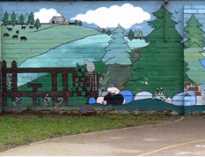 |
Chapel End Murals. | |
Beresford Road. This is one of a series of murals round the playground of Chapel End Infants School. Animals feature prominently in the scenes in the photo shown there is a black rabbit in the centre foreground. (See No. 4. on the MAP) | ||
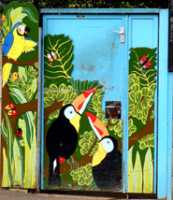 |
Church Hill Nursery School Door. | |
Woodbury Road. This a bright colourful design which disguises the the main doorway into the school. (See No. 5. on the MAP) | ||
 |
"Fellowship". |
|
On the rear wall of Walthamstow Town Hall, Forest Road. This is one of a set of five the others are "Motherhood", "Education", "Work" and "Recreation". The figure illustrating fellowship is that of William Morris. Morris was an early Socialist, a member of the Pre-Raphaelite Brotherhood and gathered together a group of artists and craftsmen and so was very influential in the Arts & Crafts Movement. Thus he was a model of fellowship. (See No. 6. on the MAP) Artist: John F Kavanagh, Date: c. 1940. | ||
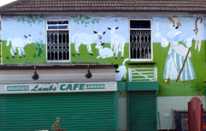 |
Lambs Cafe. |
|
On the corner of Lea Bridge Road and Raglan Road. This large mural covers two walls of the building. Picturing an old-fashioned shepherdess with young lambs it is clearly an advert for the caf�. However it is unlikely to attract many vegetarians. (See No. 7. on the MAP) | ||
 |
Henry Maynard Junior School Mosaic. |
|
Addison Road. Henry Maynard was a member of the Maynard family who owned the manor of Walthamstow Tony from the late 17th century. The family supported education and gave several large donations to local schools. The crest of Waltham Forest has two stags as supporters. One of these was taken from the crest of the Maynard family. (See No. 8. on the MAP) | ||
 |
Meridian Markers. |
|
Set into the pavement in front of 111-113 Wood Street is a marker to show the position of the Greenwich meridian. A similar one can be found on Forest Road pavement just south-west of the railway bridge near the junction with Hale End Road. There are also some more colourful markings similar to those in Leyton which were put on the pavements of other streets for the millennium, namely:
| ||
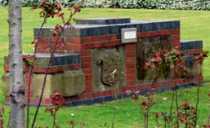 |
Sir George Monoux College. |
|
Monument in the grounds of Sir George Monoux College in Chingford Road. In 1527, Sir George Monoux, a rich city merchant who was master of the Drapers' Company and Lord Mayor of London, founded a school and donated money for the salary of it's teacher. The school was originally near the Monoux Alms Houses in Walthamstow Village which he also built. Over the years, it has been successively a boy's grammar school, a comprehensive and a sixth form college. (See No. 10. on the MAP) | ||
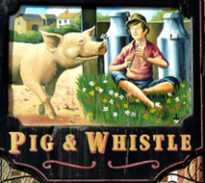 |
Pig and Whistle. |
|
187 Wood Street. This is part of Station Parade and the station opened in 1873. Despite the illustration on the pub sign, the name is a corruption of the term a peg of wassail meaning a quantity of drink. In olden times, drink was often stored in flexible leather bottles. The liquid in these bottles was subdivided by pegs which pinched the skin making a number of separate quantities which were also called pegs. Some say that the phrase taking someone down a peg or two meant reducing the amount of drink they were given. (See No. 11. on the MAP) | ||
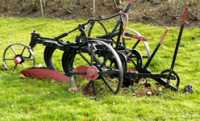 |
Plough. |
|
In front of Waltham Forest College. Forest Road. At first sight, it may seem a strange thing to find an old plough in front of a modern city college. However the area was once a series of clearings in Epping Forest which were made purposely for farming. (See No. 12. on the MAP) | ||
 |
Lord Raglan. |
|
Sign over the pub on the corner of Shernhall Street and Barclay Road. Raglan fought in the Peninsular War and at Waterloo, where he lost an arm. Note the picture shows his right sleeve is empty. In 1854 he was given command of the British forces in the Crimean war. He was victorious at the Battle of Alma; but at Balaclava he gave the order which led to the foolhardy charge of the light brigade. It is arguable whether it was his order or Lord Cardigan's interpretation of it which was the cause of the disaster. Each of their Lordships have pub named after them in East London. The Crimean winters were so cold that three items of warm clothing were named after the two Lords and the battle - the raglan overcoat, the balaclava helmet and the cardigan. (See No. 13. on the MAP) | ||
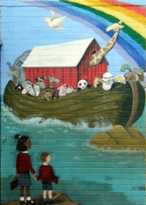  |
St. Mary's C of E School Art. | |
On the corner of Seaford Road and The Drive. Around the playground of St Mary's Church of England School there is a fine and varied display of art and mosaics by different hands. The mural of Noah's Ark is about 3 metres high. While the cricket match is part of a long frieze. (See No. 14. on the MAP) | ||
 |
The Old Shop. |
|
On the corner of Wood Street and Havant Road. This is a grade II listed building. It was built in the late 18th century and was used as a slaughterhouse and butchers shop. This was owned by the Jones family who passed it on from father to son for nearly 200 years. It is now occupied by Second Nature which sells organic foods. The tree in front of the shop (shown in this photo) is also listed in its own right. (See No. 15. on the MAP) | ||
 |
South Sea Bubble. |
|
Clock House, Wood Street is now a block of flats, but it has been much altered and added to since it was first built in about 1706. The photo shows the back of the house, which was modernised in 18th and 19th centuries. In 1713, the house was bought by a Dutch merchant called Jacob Jacobson who was later given a knighthood. Jacobson was a director of the infamous South Sea Co. In 1711, the company had been given the monopoly of trade to South America and had floated shares which became popular. As prices rose for shares, many made handsome profits when they sold. This encouraged a mad rush to invest in shares in the hope of getting rich quick and shares prices became vastly overvalued. In 1720, following a war with Spain, the bubble burst and share prices crashed. Many people were ruined. The directors of the company, foreseeing the impending crash, sold their shares at the top rate. The directors were arrested, and Clock House was sequestered to help refund shareholders; but Jacobson later bought it back. (See No. 16. on the MAP) | ||
 |
"Tragedy". |
|
On the north facing wall of Walthamstow Assembly Hall, off Forest Road. A matching sculpture of "Comedy" is on the south wall. The hall has a stage and the sculptures are a matching pair of masks symbolising drama. (See No. 17. on the MAP) Artist: John F Kavanagh, Date: c. 1938. | ||
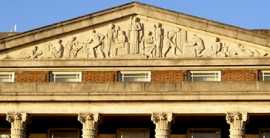 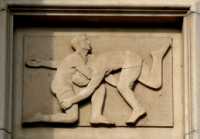 |
Waltham Forest College. |
|
Forest Road. This was college was originally called South West Essex Technical College and School of Art, when it opened in 1938. The upper sculpture seems to place more emphasis on technology and study than it does on art. The lower photo shows just one of a series along the main frontage of the college. During World War II the college was used by the armed forces for providing technical training for personnel; first by the RAF in 1940, then by the army in 1941 and then by the navy in 1942, at which time it was reclassified as a ship and called HMS Shrapnel. (See No. 18. on the MAP) | ||
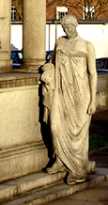 |
Walthamstow War Memorial. |
|
Forest Road. Outside the Town Hall and Assembley Hall. This features a larger than life-size female figure who is lamenting the loss of a loved one. (See No. 19. on the MAP) | ||
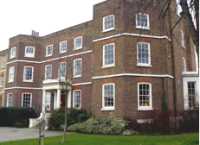 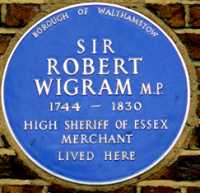 |
Sir Robert Wigram. |
|
Holy Family Technology College, Shernhall Street. Sir Robert Wigram, Bart. (1743 � 1830), described on the blue plaque as a merchant, began by being a surgeon employed by the East India Company. He prospered in his service to the company. In 1804, he became chairman of the East India Dock Co. which was responsible for the building of those docks. By then he was already a ship owner trading in his own right. In 1805 he went into partnership with George Green in his shipbuilding business, which held a monopoly for supplying ships for the East India Co. He had 23 children, many of whom died in infancy. (See No. 20. on the MAP) | ||
OTHER AREAS COVERED:-
|| Beckton || Bethnal Green || Blackwall || Bow || Bromley-by-Bow || Canary Wharf || Canning Town || Chingford || Cubit Town || Custom House || East Ham || East India Dock || Forest Gate || Higham's Park || Leyton || Leytonstone || Limehouse || Little Ilford || Manor Park || Mile End || Millwall || North Woolwich || Plaistow || Plashet || Poplar || St George's || St Katharine Dock || Shadwell || Shoreditch || Silvertown || Snaresbrook || Spitalfields || Stepney || Stratford || Upton || Walthamstow East || Walthamstow Village || Walthamstow West || Wanstead || Wapping || West India Dock || Whitechapel || Woodford || |